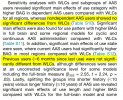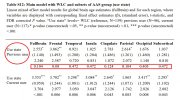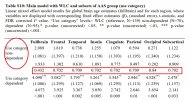[OA] Androgen Misuse and Abuse
Androgens are potent drugs requiring prescription for valid medical indications but are misused for invalid, unproven, or off-label reasons as well as being abused without prescription for illicit non-medical application for performance or image enhancement. Following discovery and first clinical application of testosterone in the 1930s, commercialisation of testosterone and synthetic androgens proliferated in the decades after World War II.
It remains among the oldest marketed drugs in therapeutic use, yet after 8 decades of clinical use the sole unequivocal indication for testosterone remains in replacement therapy for pathological hypogonadism, organic disorders of the male reproductive system. Nevertheless, wider claims assert unproven, unsafe, or implausible benefits for testosterone, mostly representing wishful thinking about rejuvenation.
Over recent decades this created an epidemic of testosterone misuse involving prescription as a revitalizing tonic for anti-ageing, sexual dysfunction and/or obesity, where efficacy and safety remains unproven and doubtful. Androgen abuse originated during the Cold War as an epidemic of androgen doping among elite athletes for performance enhancement before the 1980s when it crossed over into the general community to become an endemic variant of drug abuse in sufficiently affluent communities that support an illicit drug industry geared to bodybuilding and aiming to create a hypermasculine body physique and image.
This review focuses on the misuse of testosterone, defined as prescribing without valid clinical indications, and abuse of testosterone or synthetic androgens (androgen abuse), defined as the illicit use of androgens without prescription or valid indications, typically by athletes, body-builders and others for image-oriented, cosmetic or occupational reasons.
Handelsman DJ. Androgen Misuse and Abuse. Endocr Rev. 2021 Jan 23:bnab001. doi: 10.1210/endrev/bnab001. Epub ahead of print. PMID: 33484556. https://academic.oup.com/edrv/advance-article/doi/10.1210/endrev/bnab001/6117781
Androgens are potent drugs requiring prescription for valid medical indications but are misused for invalid, unproven, or off-label reasons as well as being abused without prescription for illicit non-medical application for performance or image enhancement. Following discovery and first clinical application of testosterone in the 1930s, commercialisation of testosterone and synthetic androgens proliferated in the decades after World War II.
It remains among the oldest marketed drugs in therapeutic use, yet after 8 decades of clinical use the sole unequivocal indication for testosterone remains in replacement therapy for pathological hypogonadism, organic disorders of the male reproductive system. Nevertheless, wider claims assert unproven, unsafe, or implausible benefits for testosterone, mostly representing wishful thinking about rejuvenation.
Over recent decades this created an epidemic of testosterone misuse involving prescription as a revitalizing tonic for anti-ageing, sexual dysfunction and/or obesity, where efficacy and safety remains unproven and doubtful. Androgen abuse originated during the Cold War as an epidemic of androgen doping among elite athletes for performance enhancement before the 1980s when it crossed over into the general community to become an endemic variant of drug abuse in sufficiently affluent communities that support an illicit drug industry geared to bodybuilding and aiming to create a hypermasculine body physique and image.
This review focuses on the misuse of testosterone, defined as prescribing without valid clinical indications, and abuse of testosterone or synthetic androgens (androgen abuse), defined as the illicit use of androgens without prescription or valid indications, typically by athletes, body-builders and others for image-oriented, cosmetic or occupational reasons.
Handelsman DJ. Androgen Misuse and Abuse. Endocr Rev. 2021 Jan 23:bnab001. doi: 10.1210/endrev/bnab001. Epub ahead of print. PMID: 33484556. https://academic.oup.com/edrv/advance-article/doi/10.1210/endrev/bnab001/6117781




